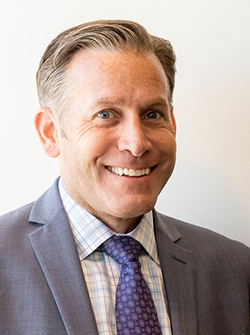As first deputy commissioner of the New York City Department of Information Technology and Telecommunications, Evan Hines is essentially the second in command to Commissioner Anne Roest. He oversees the administrative functions of the agency, while also serving as a proxy for Roest if needed. Having served at DoITT for several years, Hines has seen it evolve significantly in terms of technology and service, and has overseen some of the streamlining of its bureaucracy. In this wide-ranging interview, Hines discusses his role at DoITT, upcoming projects and how the agency is working to become more effective.
RELATED: An interview with DoITT Commissioner Anne Roest
C&S: You served as acting commissioner of DoITT for six months before Mayor Bill de Blasio appointed Anne Roest. Did serving in this capacity inform the way you understand the agency?
EH: It attached me more to the agency, made me take things a little bit more personally. Prior to that, I saw it as an organization, and really that six-month stint made it become part of the fabric of me. If there was a bad news article, or someone didn’t give us a fair crack at something while it was under my tenure, I really did take that as a reflection of, “What could I have done better?” I’ve continued that now, with being first deputy. It did give me a different perspective that we’re accountable for anything that happens in the agency and we have to be aware of that.
 C&S: How have you seen DoITT evolve during your time there?
C&S: How have you seen DoITT evolve during your time there?
EH: So my tenure at DoITT is seven years, but it goes back. I did oversight of DoITT. I worked at the (city) Office of Management and Budget, and in the mayor's office as well, and I was their liaison to DoITT, so I’ve seen DoITT under six different commissioners. While they’ve all had their own focus and each one of them had various successes, I’ve never before seen such a strong focus on our customers, and having the customer come first, and close collaboration with agencies rather than seeing ourselves as the subject matter expert and telling you how it’s best to get something done. We really – under this administration and commissioner – have become much more collaborative and much more focused on the customer, and just getting the customer what they want, not what we think they should have or should be using.
C&S: What is your role in overseeing DoITT projects?
EH: On several of them, I’m on the steering committee. So I’ll meet with the mayor’s office to do briefings. I serve with Anne and her staff on the Technology Steering Committee, so all of these projects – 311, ECTP (Emergency Communications Transformation Program) – I’m very involved in, even though there’s a program manager. So, for instance, I actually spearheaded, at Anne’s direction, the 60-day assessment that was done for ECTP when she joined the administration, to bring it back on schedule and back in budget. So I’m as involved as Anne would be on those. So if there’s issues – budgetary issues, since budget falls under me – they’ll get raised to me. It depends on the topic, but on a day-to-day basis, I have some involvement with most of them.
C&S: How do you and Roest work together to oversee DoITT?
EH: I’ll use Anne’s words, because I know how she would describe it – it’s a true partnership. She has directed staff that if they can’t get in touch with her if she’s not around, then they should come to me and my word is as good as her word. She has a lot of trust in me. She’s given me a lot of authority, and she’s wonderful to work for. She’s wonderful to learn from. She really is the full ball of wax that I haven’t seen in a lot of commissioners, where she has the government experience, the private sector experience, she is tech savvy, she’s politically savvy. So we’re partners, but I’m actually at the same time learning a great deal from her.
C&S: Are there any significant administrative challenges in running the daily operations of DoITT?
EH: We’re very heavy in process. If I were to look at the human resources process to actually hire an employee, or even the procurement process, it’s very easy for people to hide behind their city’s rules and regulations, and procurement policy board rules, that we have to follow. So if something’s not moving as fast through the cycle as we’d like it to, there can be some people – not the senior management that we currently have that came in recently – but there are some people that throw their hands up and say, "Well, it is what it is, that’s the process." We’ve been trying to break that, where there’s plenty that’s in our own control that we could actually speed up the process. Because in technology especially, you can’t have a multiyear procurement and still expect to get technology that’s going to be current at that point. By the time we would buy it, it would be already out of date.
C&S: What concrete steps are being taken to ameliorate the bureaucratic gridlock?
EH: We actually have just done a strategic plan for the agency that we’re finalizing and we’re now cascading that plan down to each of our divisions. So the guiding principles are about clients, about doing everything in a lean way – whether that’s cost, whether that’s streamlining processes. It also actually will continue after we come up with individual divisions’ strategic plans. We’ve even launched some programs to get employees involved in solving a problem. We crowdsourced a few different ideas and said to employees, “What do you think is the biggest challenge out of these three challenges we’ve listed?” The one that received the most votes, there’s now a voluntary group of employees who are meeting regularly to come up with recommendations to actually change that process, to come up with a program for that. So now we’re engaging people at all levels of the organization to come up with solutions. I don’t think that was done in the past either. I think management thought they had all the answers. But everyone’s really excited about that.
C&S: What are some other initiatives being implemented to revamp DoITT?
EH: The reorganization was the start of it, but it’s really leading to a major culture shift that is going to take a lot of work on our part to have it continue to move forward. But people have been stuck in their ways. It’s so much like an assembly line – you know, this is how we do it, and if everything veered from that process, it was problematic. So we’re breaking that. We’re installing the culture that they should work with the customers, that we need to be flexible where we can be flexible and we’re now coming up with a communications plan for how that will ensure that that will permeate throughout the organization.
C&S: What do you believe New Yorkers should know about DoITT?
EH: While we’re a technology agency, the administrative staff is just as important as the technical folks because they’re actually getting the technical folks in the door. If we don’t have those people, and if we’re not developing those people, if we’re not investing in our human capital, if we’re not putting good contracts in place and terms and conditions, it’s setting up our staff and our projects to fail. We can’t just think of it as an administrative group. We’re just as much of a contributor to the success of all the work we do as anyone else in the agency.
NEXT STORY: Open data


